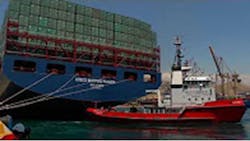Early on June 26, the inaugural transit of the Panama Canal Expansion began with the transit of Neopanamax vessel COSCO Shipping Panama through the new Atlantic-facing Agua Clara Locks.
Originally named Andronikos, the vessel was renamed to honor and pay respect to the country of Panama and the Canal. Panamanian President Juan Carlos Varela and Panama Canal Administrator and CEO Jorge L. Quijano honored the almost 40,000 workers—who made the Expansion a reality—with a message of pride, accomplishment, hope and opportunity.
“Our commitment to provide value to our customers remains paramount. In 2015, we broke our tonnage record with 340.8 million PC/UMS in the original Canal,” said Quijano. “Today, we make history and improve global connectivity. We thank our customers for their support and appreciate the 170 reservations we have received thus far to transit the Expanded Canal.”
COSCO Shipping Panama set sail June 11 from the Greek Port of Piraeus carrying 9,472 TEUs and measuring 299.98 meters in length and 48.25 meters in beam. Later this afternoon, the vessel will reach the Pacific-facing Cocoli Locks where the official Inauguration ceremony will take place.
The Expansion Program is the Canal’s largest enhancement project. It included the construction of a new set of locks on the Atlantic and Pacific side of the waterway and the excavation of more than 150 million cubic meters of material, creating a second lane of traffic and doubling the cargo capacity of the waterway.
While the Expanded locks are 70 feet wider and 18 feet deeper than those in the original Canal, they use less water due to water-savings basins that recycle 60 percent of the water used per transit.
Considered and analyzed for a decade with more than 100 studies, the Expansion will provide greater economies of scale to global commerce. It will introduce new routes, liner services, and segments (such as liquefied natural gas).
